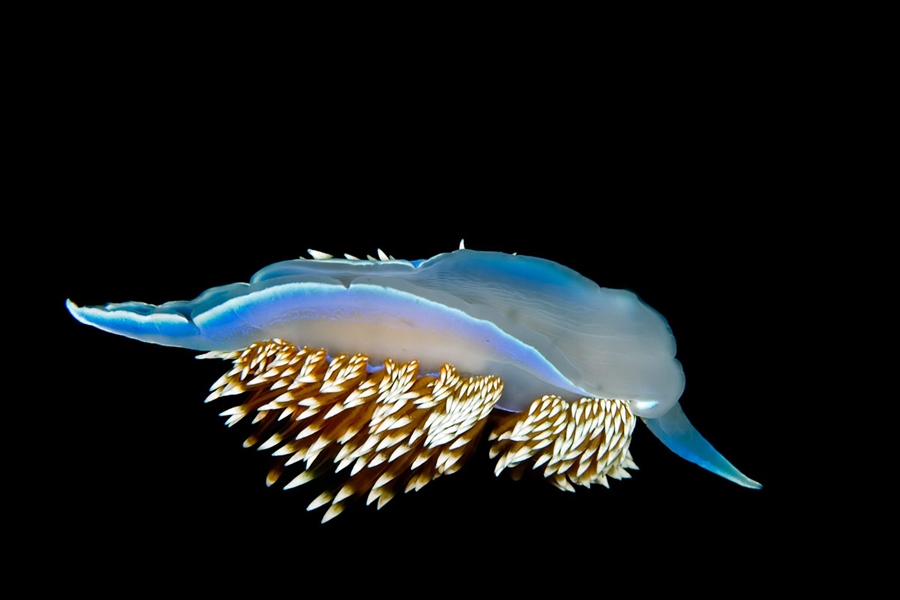 |
Hermissenda crassicornis
Photo courtesy of Kenneth Kopp
Flying Nudi's (Second installment to
last week's presentation )
Flying Nudis came about by a similar motivation - my desire to come up with a new way to see a favorite subject.
Flyer 001 for me was in SoCal about 4 years ago - back when I was still shooting a Point & Shoot Olympus 5050. It happened by accident when somebody kicked my subject off the ledge. Nudi was airborne, I took some shots. They were all terrible shots - but I liked the idea.
The first time I got serious about getting a flier was in Seattle about 2 years ago. Dive buddy Claudette and I were diving at a site called Les Davis. It was the clearest that place has been in a decade (so we would be led to believe - I loved that dive!!!) near the end of the dive, we came up on our 500th Alabaster Nudi (local name. Real name: White-lined Dirona) We were in the super shallows. Claudette brought over a perfect specimen - and it either fell off the kelp or was flicked off the kelp (depending on which of us you talk to) and I started snapping as it fell through the water.
That shot was the shot I used on my 2000 calendar, and is really flying Nudi 001. I later went on to create thank you notes from this same flyer, using 4 shots in a collage
Soon, Claudette and I were flying everything - trying to get a feel of the species and classes of Nudis that would fly well, how to light them, how to better handle them so they get back to where they belong unharmed (no nudis have been harmed in the making of these shots. I'm pretty sure. Not that a slug can talk or anything - but they all still looked sluggy and not, you know, dead, after the shots...)
All of the Aeolids fly great. Mostly because they swim well. Same for the Dendronotidae. Lots going on with their cetata (back fur) so they fall slow, and they fly great.
Dorids are a little boring. They kinda give up and just sink. Same with Navanax.
Flatworms are great! They knot up and are very active on the way down. The problem is they all start off impossibly small, then get even smaller when you fly them. I want to find a really big one some day... all my flatworm flier shots aren't great because they are simply too small.
I like shooting these with a long lens - like my 105mm. Shooting with the 60 is fine, and surely easier to frame up. Trying to keep a 1/3" to 1" slime bag falling in the water column, often at night, in frame with a 105mm telescope is challenging... But I also get to be a but further away with the 105, so I don't introduce vorticies that impact the natural progression of the fall.
Lighting them isn't real tough - I shoot everything manually. The key is to light through them, just like everything else. There is nearly always schmootz in the water, and you'll get a lot of it when you're shooting into the nothingness - so the lighting is important or else you'll spend 40 minutes on each shot picking out snow. Not that I've ever done that....
Here are some examples of some different species and how they fly. Once again, I gotta give the nod to Hermissenda. He's my fav. They are abundant, they are rugged, they are often big, they're easy to spot on the fall and they are pretty active on the way down.
BE CAREFUL! We never pry a Nudi off of any surface. If we can't waft some water and have the guy blow off or mostly blow off, we move on. We don't handle these beautiful creatures hardly at all. We waft, and then with a semi-closed hand guide them to about 5 or 10 feet above me and just let them drop. We will never fly a Nudi more than twice. If I can't get a grip in two passes, I won't get one on three. And always, always, always put them right back where you get them.
Flying a Nudi is a great way to get shots of its underside, its muscular foot, its back side, its face - all angles, really. I've learned so much about their physiology by looking at the hundreds of flier shots I've taken. I love it.
My very favorite part of flying is the sequential shots. I'll take a couple of dozen shots in very rapid succession during a fall. Once you put them together, they make a great story.
Enjoy!
Westchester, Calif
Jan. 2009
Flier 001 (Cuthoa divae ?)
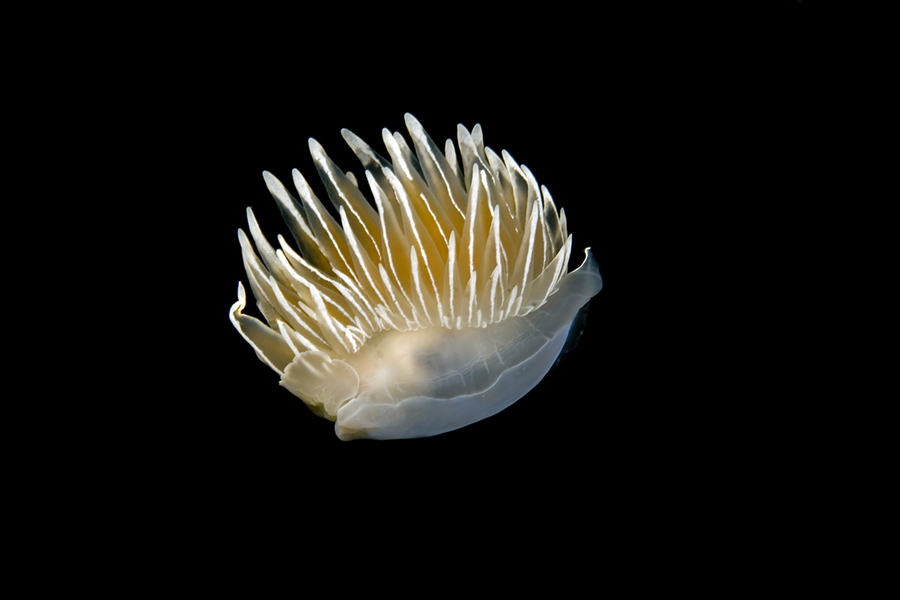
|
Hermissenda crassicornis
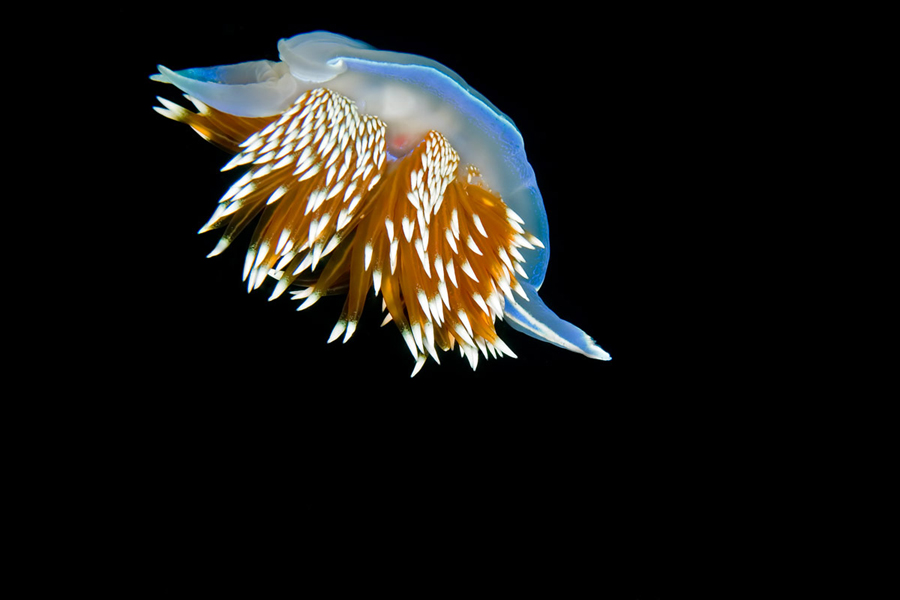
|
Dirona picta
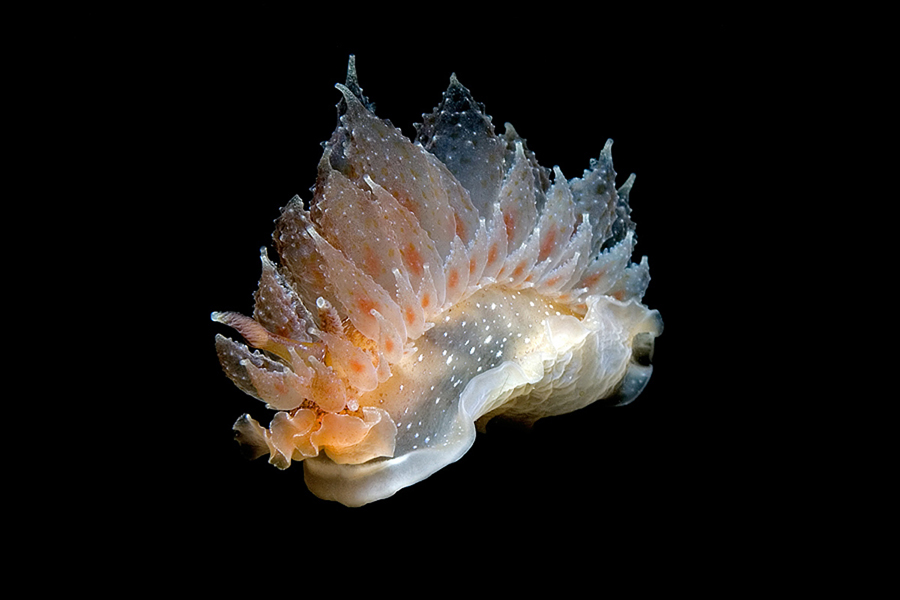
|
Dendronotus sp.
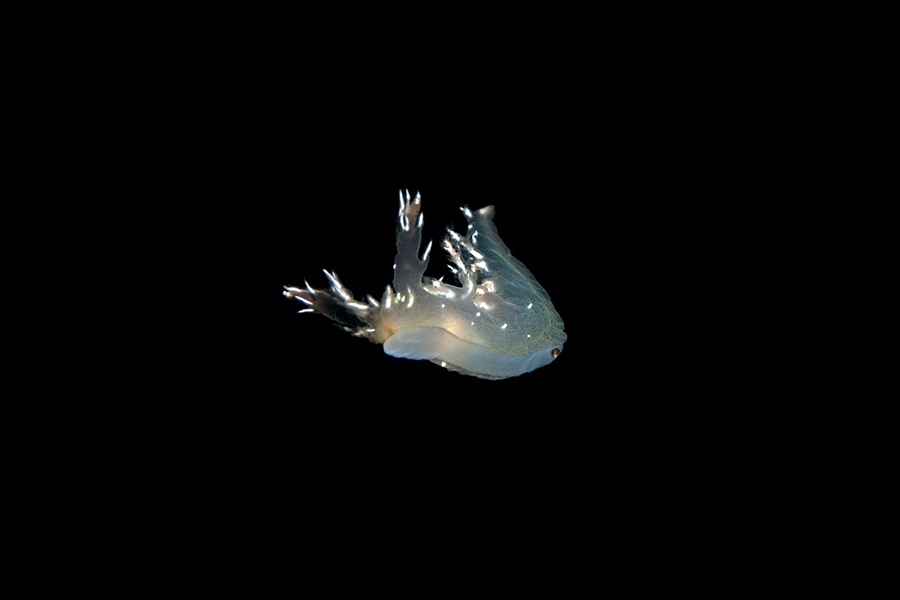
|
WEBMASTER'S NOTES: Ken and Claudette are certainly masters in the art of nudibranch photography! We are very fortunate that they are willing to share their techniques with us. Years ago Sea Slugs were my favorite subject when I first took up underwater photography. This fascination resulted in being on the receiving end of a lot of jokes by my fish photographer buddies. After all as I was told then, just what special skills are required to take a photo of a lowly sea slug? I think time has answered that question and laid to rest the question of whether slug shots were mainly "slam dunk" in nature. Really great slug shots are a challenge and looked upon as so by most of the slug photographer afficiandos I know! The advent of digital photography has afforded even more great opportunities with enhanced maco capabilities. It just seems to be getting better and better! Just ask Ken and Claudette! One of the New Year's resolutions for the ol' Webmaster is to get out in 09 and taken even more images! Even if it is HD video in my case!
Kenneth Kopp
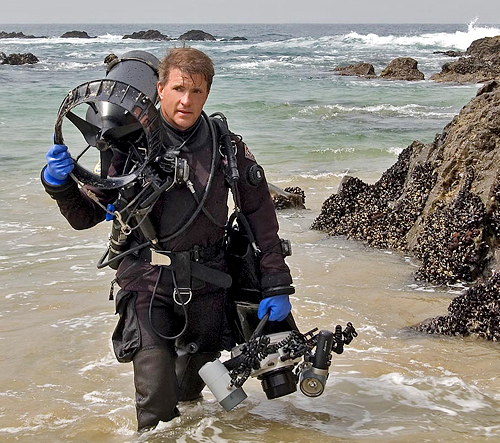
Diving since 1999. Currently doing about 260 local dives a year. Favorite Nudibranch dive is Marine Land, Palos Verdes, CA. We routinely see 12 - 14 species on a single dive there. Got my first camera in 1974. Been shooting digital exclusively since 1998. Been shooting underwater about 3 years (mostly P&S Olympus and Sony.) Moved to the current DSLR (Nikon D200 / Ikelite rig) about 9 months ago. Writer and Marketing executive by profession. When I'm dry, I'm usually fly fishing or pounding and shaking things as a working drummer & percussionist. Married, no kids. We have three house Rabbits. Yeah - its weird for me, too. See more of Ken's work at www.kennethkopp.com
Send Ken email at kenneth@kennethkopp.com
|
